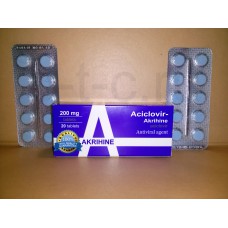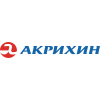Expiration date: 03/2026
Structure and Composition:
1 tablet contains acyclovir 0.2g or 0.4g.
in blisters of 10 pieces. in a cardboard bundle two packaging.
Ointment 5% 1 g contains acyclovir 0.05 g.
in tubes of 5 g in paper cartons 1 tube.
Pharmachologic effect:
Influenced converted to thymidine triphosphate of acyclovir inhibits DNA polymerase, and concurrently replacing deoxyguanosine triphosphate into the DNA synthesis of virus. It has a selective action, is active against Herpes simplex virus types 1 and 2, Varicella zoster, Epstein - Barr virus.
Pharmacokinetics:
The blood absorbed by 20%. The relatively weakly bound to plasma proteins. concentration in CSF is 50% of plasma levels. When biotransformation forms a 9-karboksimetoksimetilguanin. Return with urine in unchanged form and as a metabolite (10-15%). The average T1 / 2 - 3 hours.
Description of the pharmacological actions:
Prevents the formation of new elements disease, reduces the likelihood of cutaneous dissemination and visceral complications, accelerates the formation of crusts. It reduces pain in the acute phase of herpes zoster.
Testimony:
Infections of the skin and mucous membranes caused by the herpes simplex virus (type 1 and 2), including primary and recurrent genital herpes, herpes zoster virus and prevention of infections of the skin and mucous membranes in patients with lowered immunity.
Contraindications:
Hypersensitivity.
Application of pregnancy and breastfeeding:
Contraindicated during pregnancy (it passes through the blood-barrier). At the time of treatment should stop breastfeeding (passes into breast milk).
Side effect:
Tablets: rarely - nausea, vomiting, diarrhea, headache, fatigue, deterioration of hematological parameters, elevated levels of bilirubin in the plasma, increasing the activity of liver enzymes, allergic reactions.
Ointment: rarely - peeling at the site of application, local irritation, burning, pain.
Drug Interactions:
Probenecid slows excretion.
Dosage and administration:
Pills: Inside adults and children over 2 years in the treatment of herpetic disease - 0.2 g of 5 times a day for 5 days in immunodeficiency - single dose increased to 0.4 g for the prevention of herpes infections in immunocompromised patients - 0.2 g 4 times a day. Infections caused by herpes zoster virus, - 0.8 g of 5 times a day for 7 days. Patients with impaired renal function it is necessary to adjust the dosing regimen: if Cl creatinine less than 10 mL / min, the daily dose was reduced to 0.4 g in 2 doses with an interval between doses of at least 12 hours in the treatment of infections caused by Varicella zoster, and supportive care of patients. with a pronounced decrease in immunity and Cl creatinine 10-25 ml / min - 2.4 g / day in 3 divided doses every 8 hours in patients with Cl creatinine less than 10 mL / min, the daily dose was reduced to 1.6 g in 2 doses. every 12 h.
Children under 2 years - half the adult dose.
Ointment: put a thin layer on the affected area as soon as the first signs of the disease 5 times a day (every 4 hours) for 5-10 days.
Precautionary measures:
Be wary appoint elderly patients, patients with severe renal impairment. It is necessary to provide enhanced hydration mode. Avoid ointments mucous membranes of the mouth, nose, eyes, vagina.





